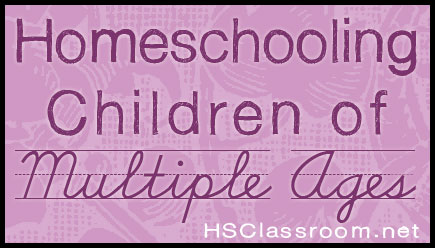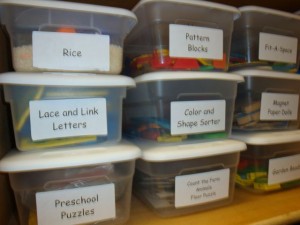advertisement
advertisement
The following is a post from contributing writer Roan, of The Joyful Johnsons.
Whether you have two or ten children of different ages that you homeschool, teaching and preparing for multiple ages of children can be challenging. Currently, I am homeschooling my five children whose ages are 6,8,13,15, and 17. The key is planning and organization.
Consider your curriculum.
Are there subjects that you can teach multiple children at once? Usually history and/or science falls into this category. Especially when you have children that are only one or two years apart in age, this seems to work well. If you use curriculum like KONOS or another unit study or Sonlight or another literature-based study, it is easy to put more than one child in the same course of study.
Consider the ages of your children.
If your children are years apart in age, then you won’t be conducting a science unit study with both a 10th grader and a 2nd grader. In this case, you will be teaching and guiding each child individually. This is doable too, with proper planning and organizing of materials.
Create a routine for you and your children to follow.
Children of all ages thrive on routine. Knowing what to expect and when to expect it each day reduces everyone’s stress. Beginning the day with all of your children together for a Bible study or read aloud period sets a nice tone for the day. This can be followed by your older children beginning their schoolwork independently while you work with your youngest ones. I always start with my youngest child, and then work my way up.
Plan independent work for all of your children.
Even a 5 year old can do something without Mama’s help. I create daily checklists and laminate them for each of my children. They mark off each item as they do it with a wet erase marker. I make sure that the daily checklist includes independent work. What can younger children do alone? Handwriting, copywork, journal writing/drawing, math (the review portions of each lesson), read a book, or play with an educational activity. As my children grow older, my list grows longer of subjects that I expect them to complete independently. I gradually add grammar and science to this list. By the time my children are in 7th-9th grade, they are completing almost all of their schoolwork independently.
Plan a meeting time with each of your children.
This is when you will do all of your direct instruction (and the younger the child, the longer this meeting will take), and it is also when you will check all of your child’s independent work. Do not skip this meeting–especially with your older children who are doing all of their work independently. Checking and correcting schoolwork daily prevents many problems. Having your child correct his mistakes or missed problems daily reinforces learning.
Plan activities for your younger children while you are working with the older ones.
I keep various activities and puzzles on a shelf in our schoolroom closet for this purpose. For very young children, I choose the activity for them, and simply set two or three things out for them to do. Older children can choose for themselves. I also allow my children to just freely play both inside and outside the house if they desire.
Keep each child’s school materials separate.
store each of my child’s schoolbooks and supplies in his own bucket or basket in the area where he completes his independent work. I include pencils, pens, calculators, crayons, etc. in this bucket. I keep all of my teacher books on one shelf in my schoolroom, but the ones that I use daily, like the math teacher’s guide with the answers, I keep in my younger child’s bucket so I have it handy when I work with him
Separate children for independent work.
It seems like a fun and cozy idea for you to have all of your children surrounding you, all working at the same table, but usually it just isn’t conducive to learning for everyone! Older children will be distracted by your drilling flashcards with your younger child, or listening to a beginning reader read aloud. I only have my two youngest (1st and 3rd graders) work at our schoolroom table–one at each end with me in the middle. My older three are spread out throughout our house so can have the quiet atmosphere that they need.
Try to schedule your read aloud time so all children can listen.
All of my children, even my older ones love for me to read aloud to them. I normally schedule my younger children’s read aloud books first, for two reasons. One–I like for them to be done with all of their schoolwork first. Two–my older children are less interested in their read alouds, usually, and they are not tempted to abandon their independent work to listen. However, I still read aloud to my 8th grader (his last year of Sonlight with read alouds), and my two oldest children usually join us. The later in the school day that I schedule his read aloud time, the better for his older sisters.
Realize that your school day will take you several hours.
Our school hours are from 8:30-3:00. All of my children, especially the younger ones do not do school this entire time. In fact, they are typically finished by lunch. However it takes me all of this time to teach, check, correct, and read aloud to all five of my children. It is reasonable to expect that schooling multiple children will take a good portion of your day.
With careful planning of your day and organizing of your materials, you can successfully homeschool children of multiple ages.
Roan is beginning her 12th year of homeschooling. You can visit her personal blog, The Joyful Johnsons to read about her family, her homemaking adventures, her running, and her homeschooling her children.
Join 40,000+ Other Awesome People
Subscribe to the Real Life at Home weekly newsletter to get our latest content, exclusive free printables, learning activities, and ideas for celebrating with your kids all year


Leave a Reply